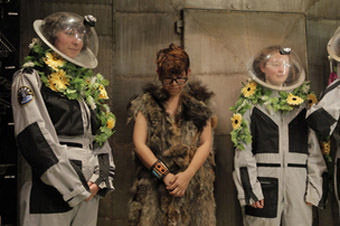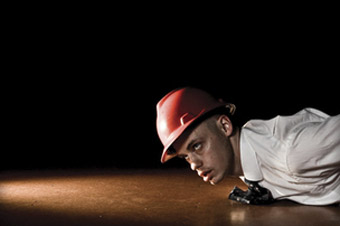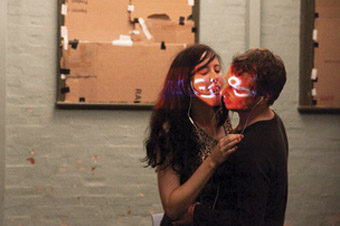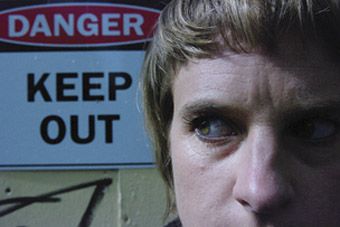next wave 2010: riding risk
keith gallasch: interview, jeff khan

Tape Projects. 100 Proofs the Earth is not a Globe
courtesy Next Wave
Tape Projects. 100 Proofs the Earth is not a Globe
CONSCIOUSLY OR NOT, ARTISTS HAVE LONG PUT AT RISK THEIR BODIES AND SOULS, AND SOMETIMES THOSE OF THEIR AUDIENCES. THEY HAVE TEMPTED THE DISFAVOUR OF CRITICS, AUDIENCES, GOVERNMENTS, MONARCHS AND DICTATORS AND LOST INCOME AND CAREERS.
For much of the 20th century, risk-taking was encapsulated in the notion of a formally and politically disruptive avant garde. In the 21st century the avant garde has been replaced by a multiplicity of agents for change, now busily reclaiming the right to risk as an aesthetic prerogative, and with utopian potential. Such an agent is Melbourne’s increasingly international Next Wave Festival, for and by young adults, directed, for the second time, by the ever energetic and clear-sighted Jeff Khan.
In an era when the artistic manifesto has been usurped by the business plan and society has become increasingly risk-averse (while contrarily wreaking environmental and financial destruction in the name of the free market), the call to experimentation is growing. If hardly a new concept for the arts, the ways in which artistic risk are being realised are evolving differently from their Modernist avant-garde antecedents. I asked Khan about the kinds of risk entailed in the works in this year’s festival.
The theme of the 2010 Next Wave Festival is, rather grandly, “No Risk Too Great.” It’s easy to say, but who and what are at risk in your program?
People inside and outside of the arts have become increasingly ‘risk averse’ so we wanted to open up a space within the festival to critically look at risk from many different angles, including the micro-management of ourselves and our behaviour in a broader cultural context—OH&S, fear of crime and all of that, which are focused on the individual, our rights, our property. We need to look beyond that in our fraught times, of environmental meltdown, of the big systems which are proving to be untenable. We need to be citizens who can step outside of our own comfort zones.
You’re doing this through art but also through talks and discussions.
Where we can drill down into the subject and address the complexity of risk.
Aesthetic risk?
Every act of creation is a risk—starting with nothing and taking a position. A risk averse culture is contrary to the artistic process putting at risk, in turn, the scale and ambition of artists’ projects.
Since at least the 1970s and 80s risk has increasingly manifested as cross-artform, intercultural and multimedia, entailing new performer-audience relationships and a pervasive engagement with media technologies. What kinds of aesthetic risks are being taken in Next Wave 2010?
It’s definitely about the dissolution of boundaries between artforms, collaborations between complementary and sometimes contradictory practices, and especially the engagement with art in a non-art context. One of the things that most excites me has been a real ramp up, for this festival, in the number and rigour of site works that make interventions into the public arena.
What are the risks for site-specific work?
It’s about making meaningful interventions but it’s also about speaking to a non-arts audience at the same time as to an arts audience.
It takes courage as well, or foolhardiness. Both are aspects of risk-taking.
It’s also about the choice of sites, of public spaces. This year’s Sports Club Project evolved out of using night clubs as sites in the last festival. This time we’re establishing a deep engagement with two sports club spaces: George Knott Athletics Reserve, which is a suburban track and field training facility and the MCG, one of the most iconic sports venues in Australia. To really meaningfully intervene in these spaces with integrity is a huge challenge. The artists visited each venue once a week for six weeks, not only getting to know the architecture, but meeting with the sports people and the stakeholders—sports administrators, little athletics clubs, security guards, operations people—to learn about the function of the space both in an operational and a cultural sense. So the artists’ works will be genuine responses to these sites.
Now they’ve assimilated these places, what will they then do in them?
There’ll be a durational event in each venue over eight hours beginning in the afternoon and comprising roving and spot performances and media art works installed in nooks and crannies. People can come and go at any time and will find themselves immersed in these altered environments.
Immersion, sensory deprivation or amplification, one-on-one performances, mass durational events, unusual locations—these are increasingly indicative of the tasks artists set themselves to attract or challenge audiences, to build them into the work.

Ashley Dyer, And Then Something Fell On My Head
courtesy Next Wave
Ashley Dyer, And Then Something Fell On My Head
Parts of the program are very immersive, very experiential, like Great Heights, which is staged across Melbourne rooftops. There are performances which are very physically confronting—Ashley Dyer’s And Something Fell On My Head is a full-length performance made entirely of objects that are choreographed to fall from the ceiling of the space towards the audience who are fitted out with safety goggles and hard hats. There are also works where audiences will become participants in unfamiliar places. The Melbourne new media arts collective Tape Projects’ 100 Proofs the Earth is not a Globe is essentially a tour of the Victorian Space Science Education Centre with performance, video and sound, transforming the educational tools. It’s a work that requires the curiosity of the audience as well as a real sense of adventure. A lot of the festival’s projects have a sense of stepping into the unknown.

Mish Grigor, Jackson Castiglione, The Short Message Service
© www.maxmilne.com
Mish Grigor, Jackson Castiglione, The Short Message Service
We’re used to the idea of performers tempting fate, as in physical theatre, but now different kinds of risks are being broached. What about Mish Grigor and Jackson Castiglione in The Short Message Service (a collaboration with Lachlan Tetlow-Stuart and Leah Shelton), where the audience text the performers instructions they must carry out? In performance art this kind of approach has sometimes been physically dangerous for the performer.
The success of the show will depend on the fearlessness of Mish and Jackson and how they handle the SMS commands from the audience. The risk is that the premise could result in something banal or something completely out of control, but what tempers it is that fearlessness and the performers’ incredible proficiency in channelling the instructions into creating situations that are dramatic and spontaneous.
And doubtless their skills at improvisation in interpreting the commands.
There’s such a complicated backend tech and media system which underpins the performance, but what elevates it is the quality of the two performers.

Paula van Beek, Dangerous Melbourne
courtesy Next Wave
Paula van Beek, Dangerous Melbourne
I’m intrigued by Dangerous Melbourne, an advisory session on how to handle the city’s perils.
It follows the format of a community information night and will be presented in a series of town halls across Melbourne where Neighborhood Watch meetings might normally happen. It’s equally a photography and performance event. Paula van Beek’s been doing surveys and research to establish what various samples of the Melbourne population find dangerous about the city. Her photography is a sometimes literal, sometimes abstract interpretation of those fears. People will be given tea or coffee and name tags and a slide show which will accurately represent their fears but also poke fun at big irrational fears in the collective consciousness.
This criss-crossing of fact and fiction is fascinating. Doomsday Vanitas likewise engages with the facticity of fear by being located in Melbourne laneways inhabited by works of art: “sharp, hologram-like projections [creating] a series of ominous still lives” in “a video game-like labyrinth.”
There’s a lovely connection with Dangerous Melbourne here, because Nicole Breedon takes iconography from literature, film and largely computer gaming culture—the icons you ‘collect’ on your visit are everyday objects but become weapons and tools of survival. Both Dangerous Melbourne and Doomsday Vanitas are about being held in thrall by our fears but also about being entertained by them while the world around us melts. What kind of gothic fantasies, for example, will be spun out of the recent volcanic eruption in Iceland?
Managing the growing scale of Next Wave must in itself involve risks. It see that your international project is aptly titled Structural Integrity.
Structural Integrity is the biggest exchange that Next wave has undertaken, with artists from the Asia-Pacific region in residence at the Meat Market. We’ve brought together 11 artist run initiatives and art collectives from across Australia and around Asia. Each is building a pavilion structure to house or represent emerging art in their region. It’s been conceived as a melancholic world fair [LAUGHS] rather then celebrating the values of nationalism. It looks at how grassroots cultures balance their work with their geopolitical position. There’ll be different takes on this. Post-Museum from Singapore are apparently meeting with 20 non-profit organisations from around Melbourne—climate change, anti-domestic violence, arts groups and charities who all believe they can change the world for the better—to organise a collective action which will determine the structure of their pavilion. It’s a utopian collectivity which really reflects the group’s position in Singapore where they support arts projects and live art but also provide a meeting point for activist organisations, as an intersection of art and politics.
The utopian aspect looks like a seriously appealing antidote to risk-aversion.
There’s a strong sense in Structural Integrity of art collectives and artist-run initiatives as providing an alternative social structure. The project is bigger than Ben Hur but it’s looking pretty stunning at the moment.
**********
In a speech about Next Wave 2010, Jeff Khan cited as inspirational the words of French philosopher Simone Weil who in 1943 wrote of risk as an “essential need of the soul,” arguing that “[t]he absence of risk produces a type of boredom which paralyses in a different way from fear, but almost as much.” Next Wave invites its audiences to accept exciting and unnerving challenges—to enter unusual non-art spaces, to become essential ingredients in or agents of creation, to be open to new forms and experiences and to talk risk, in the Risk Talkers program, as well as engage with it as art.
The demands are sometimes epic: Ultimate Time Lapse Megamix is an eight-hour dusk-til-dawn video art marathon on Federation Square’s big screen with works from Australia, Asia and the Pacific. Others are intimate: in Private Dances “audiences will be indulged with a lavish banquet and immersed in a series of private rooms, for one-on-one encounters with some of Australia’s most brilliant young dance artists.” Stranger is Bennett Miller’s Dachshund UN which will “convene a meeting of the UN Commission on Human Rights populated entirely by live dachshunds.” While I Thought A Musical Was Being Made promises “a large-scale performance on the intersection of Russell and Lonsdale Streets that the audience will watch from windows high above the on-street action.” Or you might choose to be spooked in a church crypt by the Sisters Hayes’ A Good Death or find yourself literally inside the performance of Hole in the Wall (RT95). Dive in.
The full 2010 Next Wave program can be found at http://2010.nextwave.org.au/festival/program. Participants in Structural Integrity are: Art Center Ongoing (Tokyo), Boxcopy Contemporary Art Space (Brisbane), FELTspace (Adelaide), House of Natural Fiber (Jogyakarta), Locksmith Project Space (Sydney), Post-Museum (Singapore), Six_a Artist Run Initiative (Hobart), TUTOK (Manila), Vitamin Creative Space (Guangzhou), West Space (Melbourne) and Y3K (Melbourne).
Next Wave Festival, No Risk Too Great, Melbourne, May 13-30; http://2010.nextwave.org.au
RealTime issue #96 April-May 2010 pg. web






